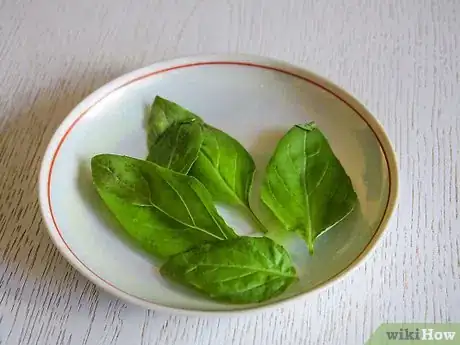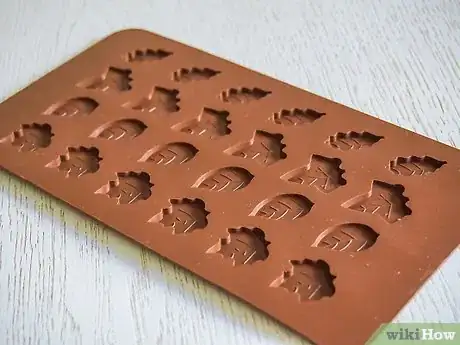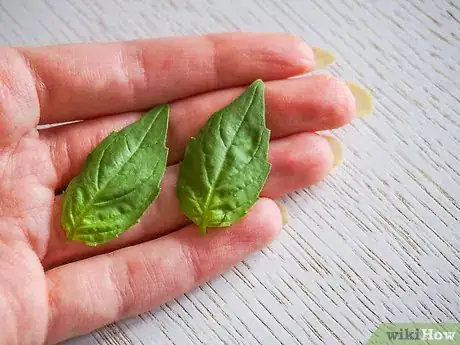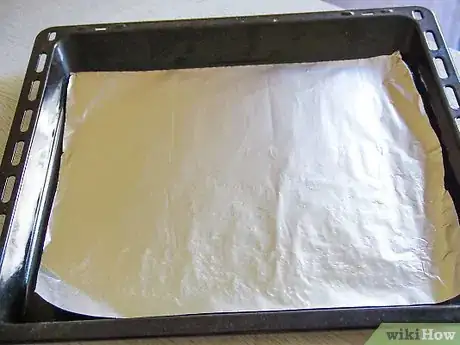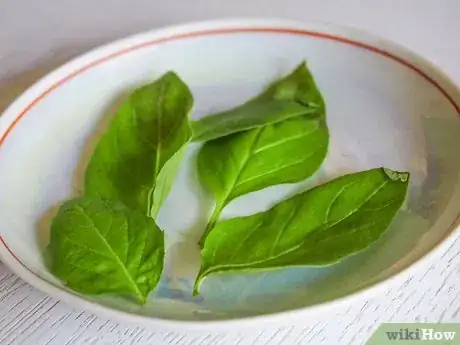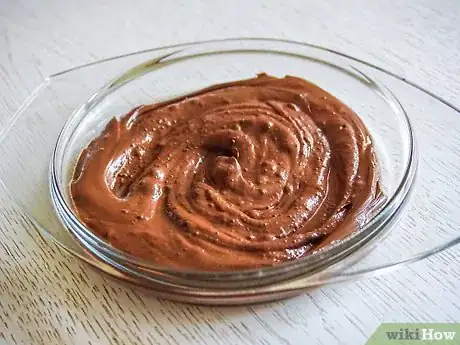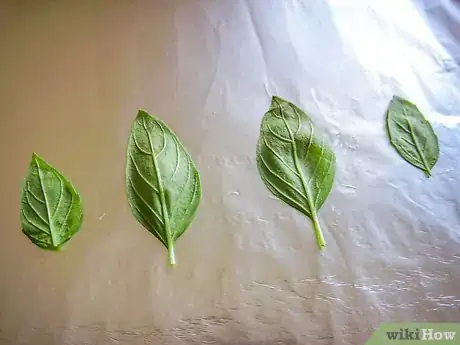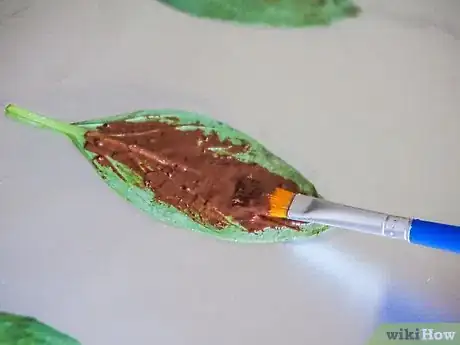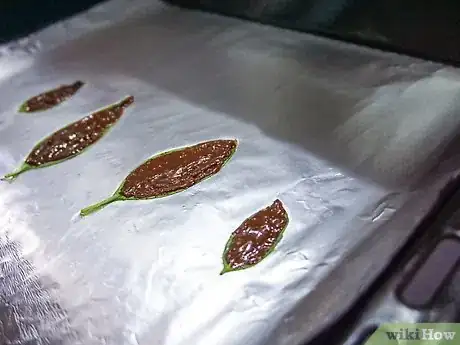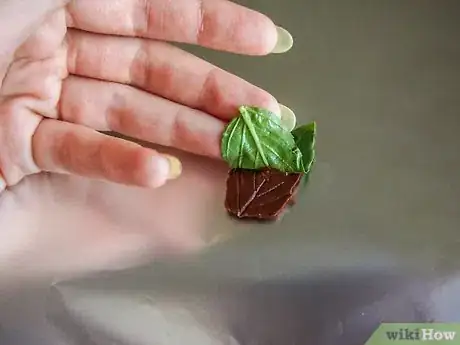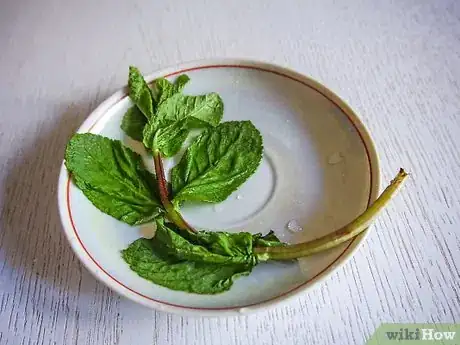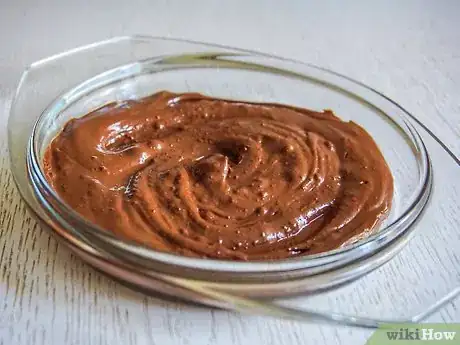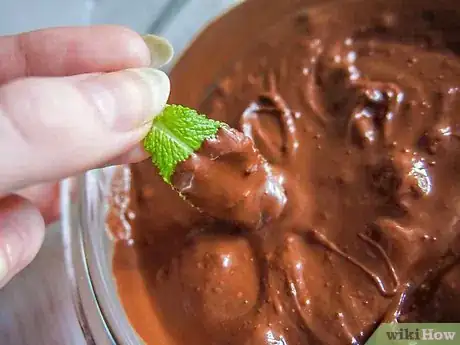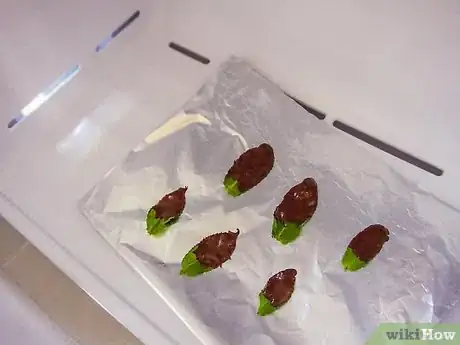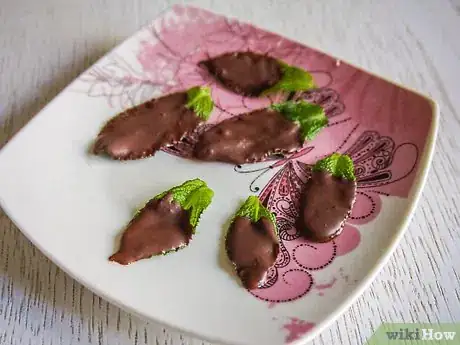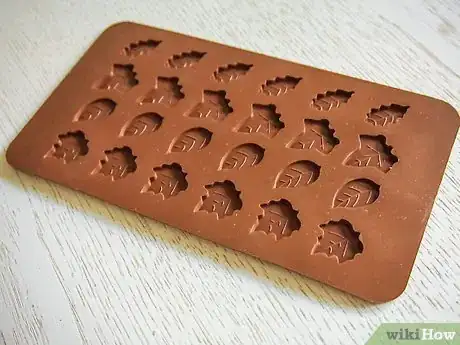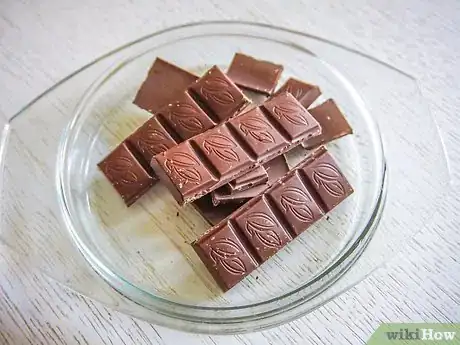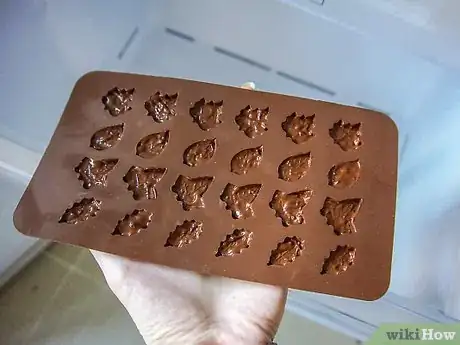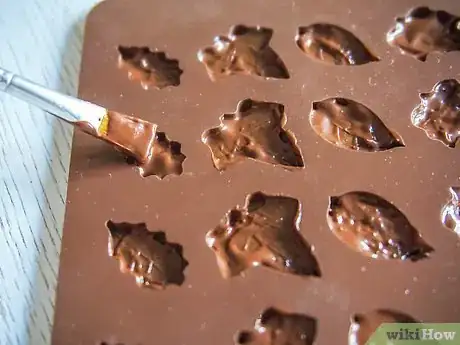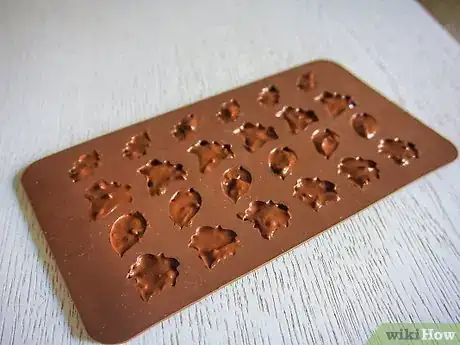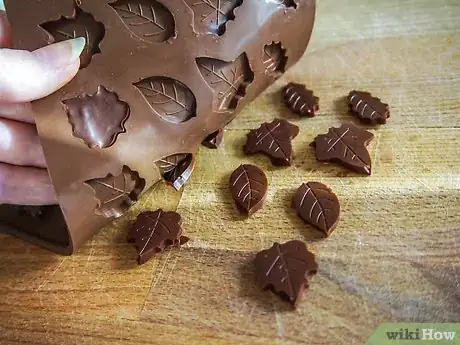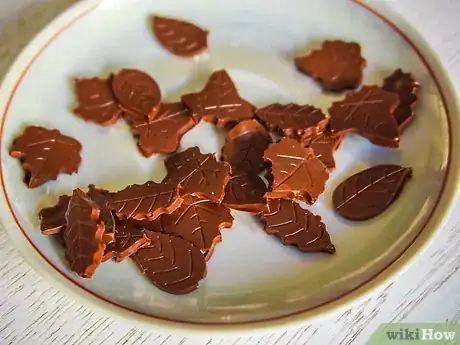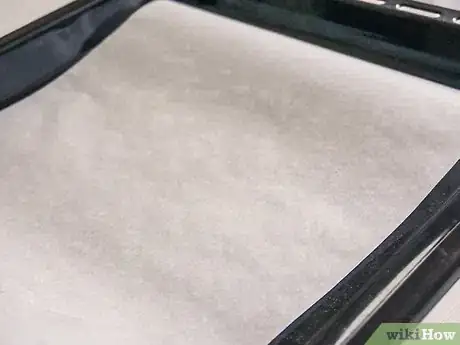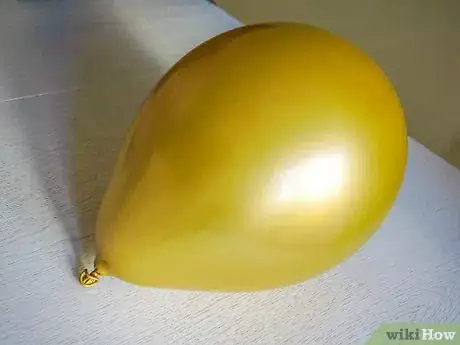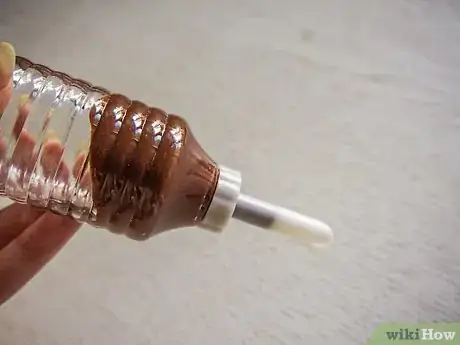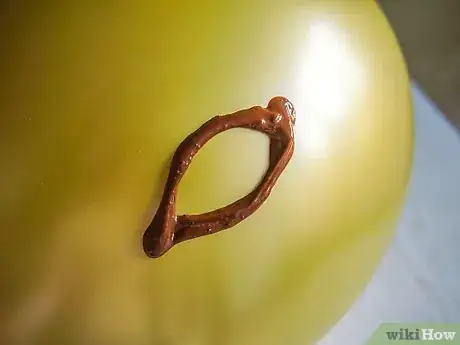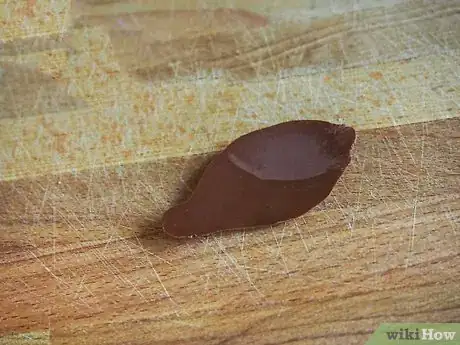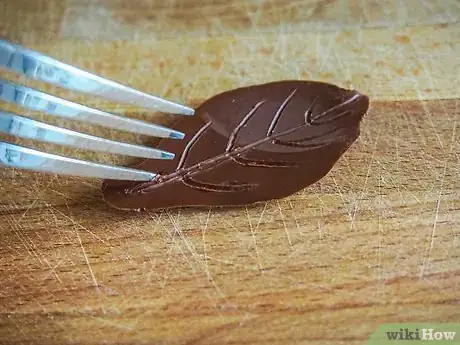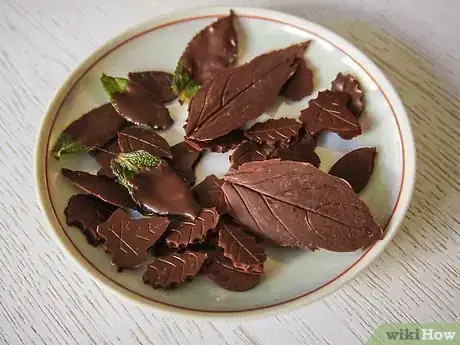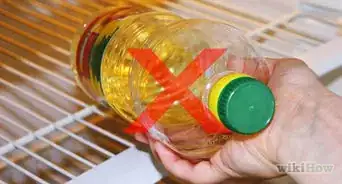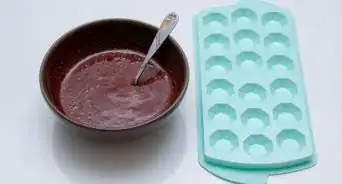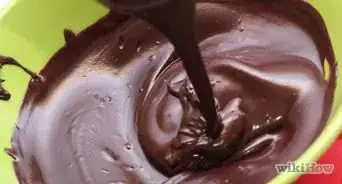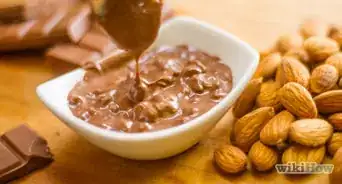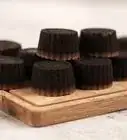X
wikiHow is a “wiki,” similar to Wikipedia, which means that many of our articles are co-written by multiple authors. To create this article, 10 people, some anonymous, worked to edit and improve it over time.
This article has been viewed 36,147 times.
Learn more...
Chocolate leaves are a delicious treat or an ideal decoration for placing on top of a cake or other food item. They can be based on real leaves or simply shaped in chocolate to look like leaves.
Ingredients
- Edible or culinary-safe leaves (see list of safe, culinary-suitable leaves in the first part of this article)
- Chocolate suitable for melting (dark, milk/dairy milk, white, flavored)
Steps
-
1Choose safe, culinary-suitable or edible leaves. If you plan on using one of the methods involving real leaves, ensure that you are 100 percent certain of the safety and origins of the leaf or leaves.
- The leaves used must be:
- Non-toxic to humans
- Not sprayed with chemical pesticides
- Allergy-safe for those consuming the chocolate.
- Leaves that can be considered safe for using to make the chocolate treat include:
- Organic mint leaves (also safe and enjoyable to eat)
- Organic lemon leaves (or orange leaves)[1]
- Organic apple or plum leaves
- Organic rose leaves.
- The leaves used must be:
-
2If you are not sure of the leaf's origins, or you do not know which leaf comes from which plant, do not use real leaves. Instead, use one of the artificial leaf methods following the Real Leaf Chocolates section.Advertisement
-
3When choosing the leaves, some things to watch for include:[1]
- Round, heart-shaped leaves are easy to work with
- Young leaves will be the easiest to peel away from the chocolate.
Advertisement
Method 1
Method 1 of 2:
Real leaf chocolates
Imprinted real leaf chocolate leaves[2]
-
1Line a baking sheet with parchment or wax paper.
-
2Pick some real leaves off one of the edible plant varieties outlined above. Wash each leaf well; they must be clean, as well as safe.
-
3Melt the dairy milk chocolate in a double boiler or in a bowl simmering over a pan of hot water.
- You could also use white or dark chocolate. Dark chocolate should be tempered before using, otherwise it will appear dull when it sets.
-
4Set the leaves out on an extra section of parchment or greaseproof paper. Place each leaf so that the back of the leaf is facing upward, as this will produce a much more interesting pattern effect on the chocolate when completed.
-
5Dip a pastry brush into the melted chocolate. Paint the backside of the leaf with the chocolate. Aim to keep a smooth and even layer across the leaf.
- Avoid dripping chocolate onto the underside of the leaf. If this happens, wipe it off with your finger. Chocolate stuck on the underside of the leaf will make it harder to peel the chocolate leaf off later.
-
6As you complete each leaf, lay it onto the baking sheet. Repeat until you've made as many leaves as you wished to make.
-
7Allow the leaves to set. This can be done in one of three ways:
- Let sit in a cool and dry area of the kitchen until set.
- Place in the refrigerator and allow to set.
- Place in the freezer and allow to set.
-
8Remove the leaf from the chocolate when the chocolate sets. Start with the stem end, as this is the strongest part you'll be able to grip. Simply peel the leaf away from the chocolate, carefully.
- If you find that the leaf veins did not transfer as well as you'd have liked, etch in additional veins with a toothpick.
-
9Either serve immediately or store. If you need to keep the leaves to serve later or to decorate a cake with, place them back on the parchment covered tray and put into the refrigerator. This will help them to retain their shape and they won't melt.
Advertisement
Chocolate dipped mint leaves
The beauty of these leaves is that you eat both the leaf and the chocolate.
-
1Pick organic, fresh mint leaves from the garden. Look for leaves that are of a decent size, unblemished and without rips or bumps. Wash and dry the leaves before proceeding.
- You can often buy organic mint leaves at the supermarket or fruit and vegetable stores if you don't grow your own. Some places also sell live mint plants for culinary usage.
-
2Melt dark chocolate in a double boiler.
-
3Dip the leaves halfway in the melted chocolate. Leave space between the leaves to prevent them from sticking together.
- Use tweezers or small tongs to help you hold the leaf by its stem, if wished.
-
4Arrange the dipped leaves on a tray lined with wax paper. Parchment paper can be used instead, if preferred.
-
5Place the covered leaves in the freezer for half an hour. They will set during this time. They can be left in the freezer for up to 5 hours if needed. Don't leave longer or they may get freezer burn and won't taste as good.
-
6Serve. Remove from the wax paper (use tweezers to help). Arrange on a lovely, dainty platter for decorative effect. These are wonderful on their own or as a beautiful garnish to any dessert.
- Serve direct from the freezer; the frozen texture is part of the eating experience.
Advertisement
Method 2
Method 2 of 2:
Artificial chocolate leaves
Chocolate leaves from molds
-
1Purchase chocolate leaf molds. You can find these from a chocolate making product supplier, kitchenware stores, or online.
-
2Purchase chocolate in either a block or in a package of small disks. Don't confuse with baker's chocolate, which is unsweetened. Do not use chocolate chips, baking chocolate or store bought chocolate bars because they are the wrong thickness/fluidity (technical word is "viscosity") for molding.
-
3Temper the chocolate. This step is extremely important to yield a visually appealing final product with the proper texture and mouth feel. Melt the chocolate over a double boiler or in a bowl sitting over a pan of bubbling water. To temper chocolate:
- For dark chocolate, heat the chocolate to 113ºF and cool to 88ºF.
- For milk and white, heat to 113ºF and cool to 82ºF.
-
4Brush a thin layer of chocolate into the leaf mold, using a pastry brush. Brush an even coating on all sides of the mold; take care to get into in all the nooks and crannies the mold might have.
-
5Place the mold into the freezer. Leave for five to seven minutes, to allow the chocolate leaves to set properly.
-
6Remove the mold from the freezer and brush on another thin layer of chocolate. Place the mold back in the freezer.
-
7Repeat this process until you have a solid shell of chocolate leaves. Depending on the size of the mold, you will probably need about seven layers to complete the leaves.
-
8When you take the final chocolate leaves out, remove them from the mold. Turn the mold gently over a counter or cutting board. The chocolates should come out without too much trouble. However, if you find them getting stuck, tap the mold firmly against the counter or flex the mold a little, and that should free them.
-
9Arrange the leaves on a serving plate. Scoff them down!
Advertisement
Large hand drawn chocolate leaf
-
1Line a baking sheet with parchment or wax paper. Make sufficient room in your freezer to put the sheet and a blown-up balloon into it.
-
2Blow up a balloon nice and firmly. Tie it off.
- Do not wash the balloon. Use a new, clean one.
-
3Place cooled melted chocolate into a piping bag. Use dark, milk or white chocolate, as long as it is good for melting.
-
4Draw a leaf outline on the balloon. Be sure to join it up to create a clear leaf shape. Do not fill it in just yet. Let the outline set.
-
5Carefully infill the leaf with melted chocolate. Either use the same chocolate or a contrasting chocolate for an interesting appearance.
-
6Place the balloon onto the baking sheet. Place in the freezer to set properly. This will take about half an hour.
-
7When set, remove from the freezer. Undo the balloon knot and slowly deflate the balloon to release the chocolate leaf. Pull the balloon off the chocolate backing.
-
8Draw leaf lines on the leaf. Use a toothpick or fork tines to scratch little lines and a middle vein.
-
9Serve. The large leaf is now ready to serve as a dessert centerpiece. Or, use it as a chocolate centerpiece and arrange other chocolates around the large chocolate leaf.
-
10Finished.
Advertisement
Warnings
- Although some sites recommend various ornamental tree leaves as "culinary-safe", the only tree leaves suggested here are fruit leaves from lemon or orange trees. The reason for this is that it is too easy to mistake the tree, or mix up safe tree leaves with toxic tree leaves even within the same species. Cooks shouldn't have to spend all their time being botanists. Moreover, "systemic" build-up of pesticides is impossible to ascertain with trees you have no control over; it's best to keep chemistry experiments to just the kitchen.⧼thumbs_response⧽
- Many leaves are toxic or poisonous. If in doubt, do not use real leaves.⧼thumbs_response⧽
- Chocolate will seize if water is added during the melting process. If this happens, the chocolate will not be useful for molding but you can still let it dry as a lump and snack on it!⧼thumbs_response⧽
Advertisement
Things You'll Need
- Safe, culinary-suitable or edible leaves
- Double boiler or bowl and saucepan
- Water
- Pastry brush
- Piping bag (where relevant)
- Balloon (where relevant)
- Leaf mold (where relevant)
- Parchment paper/greaseproof paper
- Baking sheet or tray
References
- ↑ 1.01.1Chocolate - Leaves, http://www.craftybaking.com/howto/chocolate-leaves?baking911=true
- ↑ http://www.finecooking.com/videos/how-to/chocolate-leaves.aspx
- Imprinted real chocolate leaves adapted from: Fine Cooking, How to make chocolate leaves, http://www.finecooking.com/videos/how-to/chocolate-leaves.aspx
About This Article
Advertisement
